
Baroque painting is the painting associated with the Baroque cultural movement. The movement is often identified with Absolutism, the Counter Reformation and Catholic Revival, but the existence of important Baroque art and architecture in non-absolutist and Protestant states throughout Western Europe underscores its widespread popularity.
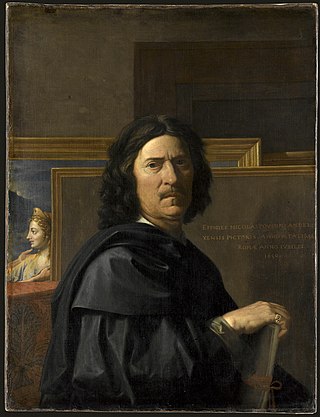
Nicolas Poussin was the leading painter of the classical French Baroque style, although he spent most of his working life in Rome. Most of his works were on religious and mythological subjects painted for a small group of Italian and French collectors. He returned to Paris for a brief period to serve as First Painter to the King under Louis XIII and Cardinal Richelieu, but soon returned to Rome and resumed his more traditional themes. In his later years he gave growing prominence to the landscape in his paintings. His work is characterized by clarity, logic, and order, and favors line over color. Until the 20th century he remained a major inspiration for such classically-oriented artists as Jacques-Louis David, Jean-Auguste-Dominique Ingres and Paul Cézanne.
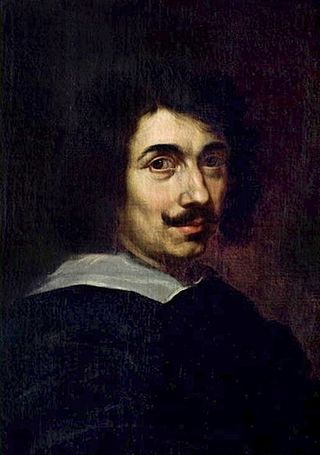
Claude Lorrain was a French painter, draughtsman and etcher of the Baroque era. He spent most of his life in Italy, and is one of the earliest important artists, apart from his contemporaries in Dutch Golden Age painting, to concentrate on landscape painting. His landscapes are usually turned into the more prestigious genre of history paintings by the addition of a few small figures, typically representing a scene from the Bible or classical mythology.

Joseph Wright, styled Joseph Wright of Derby, was an English landscape and portrait painter. He has been acclaimed as "the first professional painter to express the spirit of the Industrial Revolution".
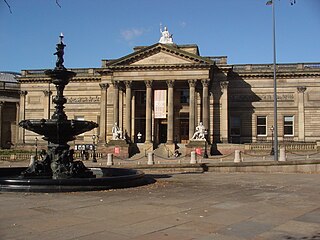
The Walker Art Gallery is an art gallery in Liverpool, which houses one of the largest art collections in England outside London. It is part of the National Museums Liverpool group.

National Museum Cardiff is a museum and art gallery in Cardiff, Wales. The museum is part of the wider network of Amgueddfa Cymru – Museum Wales. Entry is kept free by a grant from the Welsh Government.

Gaspard Dughet, also known as Gaspard Poussin, was a French painter born in Rome.
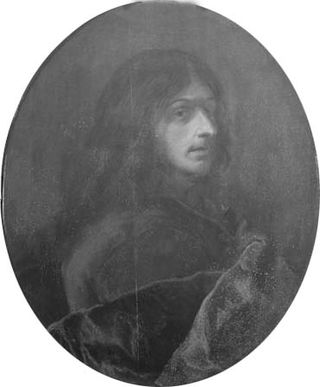
Sébastien Bourdon was a French painter and engraver. His chef d'œuvre is The Crucifixion of St. Peter made for the cathedral of Notre Dame.

The Glass House, or Johnson house, is a historic house museum on Ponus Ridge Road in New Canaan, Connecticut, built in 1948–49. It was designed by architect Philip Johnson as his own residence. It has been called his "signature work".
Events from the year 1648 in art.

The Funeral of Phocion is a 1648 landscape painting, also known as The Burial of Phocion, Landscape with the Funeral of Phocion and Landscape with the Body of Phocion Carried out of Athens, by the French artist Nicolas Poussin. Phocion was an Athenian statesman from the 4th century BC.

The Four Seasons was the last set of four oil paintings completed by the French painter Nicolas Poussin (1594–1665). The set was painted in Rome between 1660 and 1664 for the Duc de Richelieu, the grand-nephew of Cardinal Richelieu. Each painting is an elegiac landscape with Old Testament figures conveying the different seasons and times of the day. Executed when the artist was in failing health suffering from a tremor in his hands, the Seasons are a philosophical reflection on the order in the natural world. The iconography evokes not only the Christian themes of death and resurrection but also the pagan imagery of classical antiquity: the poetic worlds of Milton's Paradise Lost and Virgil's Georgics. The paintings currently hang in a room on their own in the Louvre in Paris.
By his absolute humility, by his effacement of himself, by his refusal to use any tricks or overstate himself, Poussin has succeeded in identifying himself with nature, conceived as a manifestation of the divine reason. The Seasons are among the supreme examples of pantheistic landscape painting.
Jamais peut-être, dans toute la peinture occidentale, des choses aussi nombreuses et parfois si difficiles n'avaient été dites avec une telle simplicité. Jamais un peintre ne s'était aussi pleinement identifié à l'ordre du monde. Mais cette identification n'est ni « une projection » ni une confidence : là est le sens de cette impersonalité que l'on a pu reprocher à Poussin, et qui fait sa grandeur.

The Seven Sacraments refers to two series of paintings of the seven sacraments by the French painter Nicolas Poussin.

Indian Widow is a painting by Joseph Wright of Derby, completed in late 1783 or early 1784 and first shown in his solo exhibition in London in 1785. The painting is since 1961 in the collection of Derby Museum and Art Gallery.

Gainsborough Dupont was a British artist, the nephew and pupil of Thomas Gainsborough, R.A.

Landscape with Orpheus and Eurydice is a 124 × 200 cm oil-on-canvas painting by the French artist Nicolas Poussin, painted between 1650 and 1653. It depicts a mythological subject in the classical style and is in the collection of the Louvre in Paris.

The Inspiration of the Poet is an oil-on-canvas in the classical style by the artist Nicolas Poussin, painted between 1629 and 1630. It is currently held and exhibited at the Louvre in Paris.
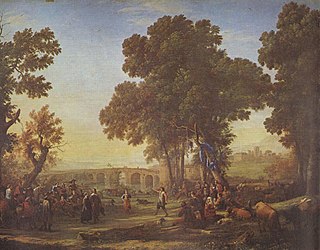
Village Fête is an oil-on-canvas by French artist of the Baroque Claude Lorrain, painted in 1639 and given to Louis XIV in 1693 together with its companion Seaport at Sunset, by landscape architect and gardener André Le Nôtre. It is currently held and exhibited at the Louvre in Paris.

The Adoration of the Shepherds is a painting of 1633–34 by the French painter Nicolas Poussin (1594–1665), now in the National Gallery, London. It is in oils on canvas, and measures 97.2 by 74 centimetres. Unusually for Poussin, it is signed "N. Pusin.fe" ["fecit"] on the stone at lower right. By 1637, soon after it was painted, it was owned by Cardinal Gian Carlo de' Medici (1611–1663), the second son of Grand Duke Cosimo II of Tuscany and was placed in his villa outside Florence.

















